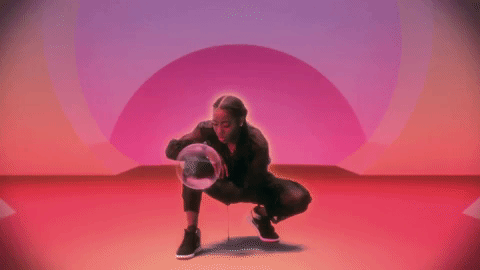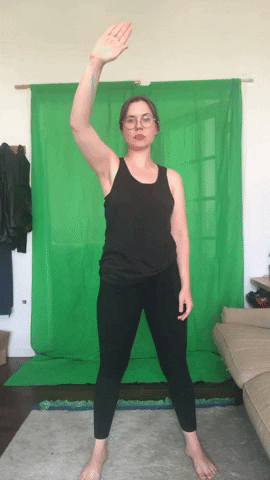Conversations: Nicole Ginelli
Gallery




Ericka Beckman, Hiatus, 1999-2015, Installation

The Jacksons' Can You Feel It? video by Robert Abel & Associates







There’s a trippy quality about digital artist Nicole Ginelli’s work. It transports you. Though, to where exactly is yet to be determined. But what is clear is that Ginelli’s universe occupies a space splashed with a psychedelic palette reminiscent of Lisa Frank but with a tinge of something...darker.

There’s a deep referential quality about it—a familiarity—yet you can’t quite pin it down. Perhaps, that’s the point. Ginelli, who has worked as an artist, animator, and director for the better part of a decade has cultivated an artistic process that involves consuming images from television, film, everywhere really, with a voracious appetite.
“I'm always screen-shotting things I see on Instagram or online. If I'm watching a movie, I'll usually screenshot it on the computer because I [cast] it to the TV or whatever,” Ginelli explains over video chat to Britt Julious in the fall of last year.
She then catalogs the materials and stores them away for the next project. When she’s ready to create again Ginelli dives headfirst into her trove of inspiration. This in itself is a massive undertaking.
“At the beginning of every project, I go through all the images, which is time-consuming. It's a full day. But it's my favorite part of the process now, is the ideation, and the thinking. It's interesting. If I'm working on a new project I can't drop it,” says the Brooklyn-based artist.

Those images came in handy while directing the music video for Sufjan Stevens’ “Video Game,” featuring choreographer Jalaiah Harmon, whose “Renegade” dance sequence went viral on Tik Tok in 2020. Between Ginelli’s abstract set, Stevens’ whispy vocals, and Harmon’s interpretive dance moves it was an amalgamation of unique styles. Who would’ve thought everything would fit together so snugly?

Stevens’ team had already booked Harmon and explained to Ginelli that the video should feel like viewers are in a video game. She was given free rein to interpret those directives as she pleased, delivering a meditative, VR-like experience.
“There's this artist, Ericka Beckman I really like, she's a video artist,” Ginelli says raising an eyebrow. “I want to pay homage to her because [she] comes up...with every project, I'll revisit her stuff. But she made this piece in 1999 called Hiatus. It's about a strange [interactive virtual reality]. A woman jumps into a V.R. headset and enters a game and then there's all of these foibles and characters that are kind of messing with her and it’s this interesting narrative. Ericka Beckman is always making work about games specifically and strange patterns in games.”

Ericka Beckman, Hiatus, 1999-2015, Installation
Groundbreaking ‘80s animators from Robert Abel & Associates—the production company behind the 1982 sci-fi flick Tron— as well as the Jackson Five’s iconic Can You Feel It music video, were also a source of inspiration for “Video Games.” Feeling and color took precedence over the typical narrative structure we’ve come to expect for music videos. The result is a feast for the eyes.

The Jacksons' Can You Feel It? video by Robert Abel & Associates

I wanna be my own believer 🕹 I wanna be my own believer 🕹

The “Video Games” set featured all women, though due to the pandemic, Ginelli was forced to work with her team in isolation. She remotely directed from her Brooklyn home, while her all-female crew worked in Atlanta, where Harmon is based.


While it was Ginelli’s first time working with a viral creator, it’s not the first time she’s dabbled in internet ephemera.
In 2015, during a presidential election cycle that feels like it happened eons ago, a certain subset of Bernie Sanders supporters was given a name: Bernie Bros. The phrase effectively captured the annoying Bernie Sanders “bro” fans, that pervaded our social media timelines.
Ginelli, also a Sanders supporter, grew exhausted with the fratty “Bernie bro” stereotype. After all, the Vermont senator also had a large female constituency. So she created a counter statement to bolster the women of Sanders’ movement: T-shirts emblazoned with the name “Bernie” in the classic pink Barbie font across the chest. It was a viral hit, patriarchy be damned.

While Ginelli may have flexed her muscle in recent years on independent projects, she’s also familiar with the 9 to 5 grind. She’s worked as an art director at Bandcamp, an interactive designer at Pitchfork and a teacher at Pratt. And it’s those experiences that have pushed her to look at the culture of creative work from all sides, not just as an artist.
“I started out as an interface designer and it's technical, boring work, but from there I got more and more creative and weirder and wilder,” she says. “I had a real job like normal nine to five. And then I was like ‘no.’ So with each project, I'm always trying to insert a new technical skill, which is kind of not the smartest [decision] because it makes the project harder,” Ginelli says.
It’s that kind of thinking that gives the artist, director and animator a leg up. There’s a certain romanticism attached to quitting a day job in favor of working as an independent creator, but it’s not easy. For starters, you have to challenge yourself. With every project, Ginelli intentionally adds a new skillset. “I just don't want to keep doing the same thing,” she says.
For Ginelli it’s all about being a great leader. She experienced firsthand what it’s like to be led by people who haven’t the slightest clue what her job and those of her colleagues’ jobs entail. Through her myriad experiences, she’s already begun having an understanding of what everyone’s job is.
“When you're an artist that's also technical and you have people above you that aren't artists or aren't technical, it's like 'no,' you should not be leading this team,” she says. “So I've always noted in my head, throughout my career, if and when I get to that stage where I'm leading other people, I want to be a technical leader.”
As for her technical experience? For starters, there was the 360-degree interactive music video of the Seahawks’ track, Eyes of the Moon in 2019. One YouTube commenter described it as “like slipping into a dream,” and they could not be more accurate. The video was inspired by throwback Macintosh computer games like Spectre, which was released in 1991.
It’s hard not to be pulled into a trance, as you’re instantly immersed into a dazzling world that explores the relationship between light and architecture. Ginelli also created the visuals for neoclassical, electronic composer Don Slepian’s live performance in the Ambient Church series. It’s the kind of immersive music experience that you’d feel pretty damn lucky to see live, an experience we’re all no doubt salivating for once the pandemic is over.
Those are just some of the nuts and bolts of Ginelli’s work. As for now, she’s recently entered her final year of grad school for her master’s degree at NYU’s Interactive Telecommunications Program and yes that sounds “very ‘80s” as Ginelli explains it. The goal? While there are numerous MFA programs for media arts, she’s after an MPS which is a master’s of professional studies.
"I just wasn't drawn to get an art degree, I was drawn to the technical stuff. It's been great. I love the program,” she says. “It's a weird time right now because it's all over Zoom or whatever, so that's kind of crazy. I'm grateful we got the first two semesters, in person.”
Despite Ginelli’s diverse portfolio of work, she will be the first to admit that her ascent as a creative has hit a few snags. In 2020, between the newly adapted quarantine lifestyle, grad school, and work, she bit off a little more than she could chew with one client.
“When I pitched my idea I was like, ‘Oh, I'll just [learn this new technology]. It's easy. And it was so hard! It was crazy,” she says ominously. “It was a lesson: yes, do new technology but not alone.” While Ginelli’s ego may have suffered a few bumps and bruises, she made it to the finish line. “It was a mistake because first I chose a technological barrier that was way too high and second I did it alone. You always should have a team when it's for a big project, you know?”

Experience is the best teacher and when you are a teacher, it inspires the best lessons. There is nothing like experiencing failure firsthand and sharing that wisdom with your students. “When I give lectures to students,” she says excitedly, “I'm always like, ‘try and fail.’ You'll get so much further in your work than trying to control everything.”
In many circles, the word “failure” is still hard to say, let alone admit. We talk around it, choosing ambiguous phrases to describe what it really is. We instead choose phrases like “I miscalculated” or “I had an error in judgment.” Anything but the hard-edged “F” word. Ginelli has confidently used the phrase multiples times when discussing her defeats. She’s clear about the need to fail and how it’s been vital to her growth.
“The good will always outweigh the bad, even though you will fail—like when you push yourself to try something experimental or new or not the exact right way to do things. There is failure in that for sure. But there's also the gain of something,” she says assuredly. “You know, that is so much bigger than what you get out of some rigid, defined process, that a bunch of dudes made up.”


